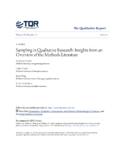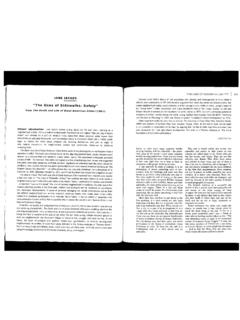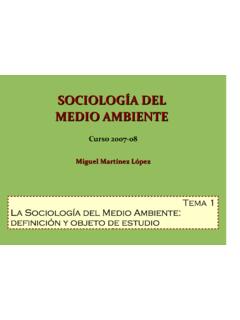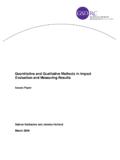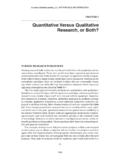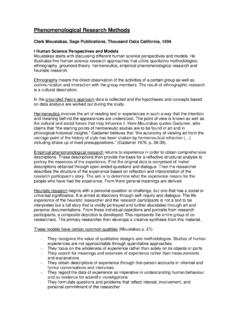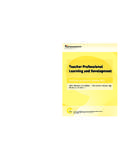Transcription of Sampling in Qualitative Research: Insights from an ...
1 The Qualitative ReportVolume 20|Number 11 Article 511-9-2015 Sampling in Qualitative research : Insights from anOverview of the methods LiteratureStephen J. GentlesMcMaster CharlesMcMaster PloegMcMaster University School of Ann McKibbonMcMaster this and additional works at: of theQuantitative, Qualitative , Comparative, and Historical Methodologies Commons, andtheSocial Statistics CommonsThis Article is brought to you for free and open access by the The Qualitative Report at NSUW orks. It has been accepted for inclusion in TheQualitative Report by an authorized administrator of NSUW orks. For more information, please APA CitationGentles, S. J., Charles, C., Ploeg, J., & McKibbon, K. (2015). Sampling in Qualitative research : Insights from an Overview of theMethods Qualitative Report,20(11), 1772-1789. Retrieved in Qualitative research : Insights from an Overview of theMethods LiteratureAbstractThe methods literature regarding Sampling in Qualitative research is characterized by importantinconsistencies and ambiguities, which can be problematic for students and researchers seeking a clear andcoherent understanding.
2 In this article we present Insights about Sampling in Qualitative research derived froma systematic methods overview we conducted of the literature from three research traditions: groundedtheory, phenomenology, and case study. We identified and selected influential methods literature from eachtradition using a purposeful and transparent procedure, abstracted textual data using structured abstractionforms, and used a multistep approach for deriving conclusions from the data. We organize the findings fromthis review into eight topic sections corresponding to the major domains of Sampling identified in the reviewprocess: definitions of Sampling , usage of the term Sampling strategy, purposeful Sampling , theoreticalsampling, Sampling units, saturation, sample size, and the timing of Sampling decisions. Within each sectionwe summarize how the topic is characterized in the corresponding literature, present our comparative analysisof important differences among research traditions, and offer analytic comments on the findings for that identify several specific issues with the available guidance on certain topics, representing opportunities forfuture methods authors to improve our collective research methods , Sampling , Grounded Theory, Phenomenology, Case Study, MethodsLiterature, Literature Review, Systematic Review, Systematic methods OverviewCreative Commons LicenseThis work is licensed under aCreative Commons Attribution-Noncommercial-Share Alike article is available in The Qualitative Report: Qualitative Report 2015 Volume 20, Number 11, Article 4, 1772-1789.
3 Sampling in Qualitative research : Insights from an Overview of the methods Literature Stephen J. Gentles, Cathy Charles, Jenny Ploeg, and K. Ann McKibbon McMaster University, Hamilton, Ontario, Canada The methods literature regarding Sampling in Qualitative research is characterized by important inconsistencies and ambiguities, which can be problematic for students and researchers seeking a clear and coherent understanding. In this article we present Insights about Sampling in Qualitative research derived from a systematic methods overview we conducted of the literature from three research traditions: grounded theory, phenomenology, and case study. We identified and selected influential methods literature from each tradition using a purposeful and transparent procedure, abstracted textual data using structured abstraction forms, and used a multistep approach for deriving conclusions from the data.
4 We organize the findings from this review into eight topic sections corresponding to the major domains of Sampling identified in the review process: definitions of Sampling , usage of the term Sampling strategy, purposeful Sampling , theoretical Sampling , Sampling units, saturation, sample size, and the timing of Sampling decisions. Within each section we summarize how the topic is characterized in the corresponding literature, present our comparative analysis of important differences among research traditions, and offer analytic comments on the findings for that topic. We identify several specific issues with the available guidance on certain topics, representing opportunities for future methods authors to improve our collective understanding. Keywords: Qualitative research methods , Sampling , Grounded Theory, Phenomenology, Case Study, methods Literature, Literature Review, Systematic Review, Systematic methods Overview Merriam-Webster Dictionary defines Sampling as the act, process, or technique of selecting a representative part of a population for the purpose of determining parameters or characteristics of the whole population.
5 This popular understanding, however, differs from some of the understandings held by researchers and scholars in the Qualitative research domain. Influential Qualitative methods authorities from diverse backgrounds have contributed to these latter understandings, and there is much natural variation in the Sampling -related ideas they present. The existence of even subtle inconsistencies, ambiguities, or incomplete descriptions in the methods literature regarding certain Sampling -related issues can be problematic for students and researchers seeking to develop a coherent understanding of Sampling that is applicable to their research situation. This problem can be exacerbated by the fact that these individuals often lack the time to search, retrieve, and review the Qualitative methods literature systematically and exhaustively to develop comprehensive and balanced knowledge of the available methods guidance.
6 Even seasoned Qualitative researchers, who are usually expertly versed in the methods of their chosen research approach or tradition, may come to prefer and become most intimately familiar with the ideas of a subset of methods authors within that tradition. Thus, they may not be comprehensively familiar with the full range of opinions across authors (including any inconsistencies among them) within their tradition regarding a specific methods issue something that can only be revealed through systematic comparison. Systematic comparison in turn depends on systematic selection of the literature to be compared. Systematically 1773 The Qualitative Report 2015 searching and selecting the methods literature, however, is generally more burdensome than it is for the empirical findings literature. This is because a greater proportion of the methods literature is found in books and edited book chapters, which take substantially more time and effort to identify, retrieve, and scan for relevant content compared to journal articles.
7 To fill the need for rigorous synthesis of the guidance on Sampling in Qualitative research , we conducted a systematic methods overview our term for a defined approach to reviewing the methods literature from diverse sources, described here. This review method involved a rigorous and transparent, yet purposeful, approach to searching the methods literature aimed at selecting and reviewing the most influential publications ones that students and researchers from multiple jurisdictions are most likely to encounter among the available writings that address Sampling . We chose the literature of grounded theory, phenomenology, and case study because these are popular approaches or traditions used in many health-related disciplines, and are also sufficiently different to allow instructive comparisons to be made within each of the Sampling topics addressed below.
8 Our findings are organized under eight distinct topic sections corresponding to the major domains of Sampling identified in the review process. In each section, we summarize how the topic is characterized in the literature reviewed, present a comparative analysis of differences among the three research traditions, and finally offer comments representing our analysis of the clarity, consistency and comprehensiveness of the available guidance from the authors reviewed on that topic and potential areas in which more clarity could be provided. Importantly, it is neither our aim nor our intention to convey personal opinions or recommendations about how to do Sampling in this review. By unifying the findings and discussion within topic sections, we aim to make it convenient for readers to locate content for any single Sampling topic in one place.
9 The Three research Traditions Reviewed Each of the three traditions whose methods literatures were reviewed is characterized by its unique approach to data collection and analysis, which in turn underlies important variation in researchers approaches and attention to Sampling . We briefly review some of the relevant differentiating characteristics of each. Grounded theory, with its origins in symbolic interactionism, is a flexible method for developing substantive theory that traditionally emphasizes understanding of social processes, although it is also recognized for its utility in explaining broader phenomena (Charmaz, 2006, 2014; Corbin & Strauss, 2008, 2015). Its traditional reliance on interview data and to a lesser extent document data, and its emphasis on constant comparison and emergent analysis, have important implications for approaches to Sampling .
10 Phenomenology is a Qualitative approach in which researchers aim to develop new understandings of human lived experience, relying on first person accounts generally obtained through participant interviews. Different methods authors have developed several distinct sub-approaches to analysis, which reflect the philosophical premises of the historically influential thinkers on whose ideas the research approach was founded (Creswell, 2013). Although grounded theory and phenomenology are sometimes considered true methodological traditions (whose epistemological and methodological positions can be traced to philosophical roots), case study is much less so. As Stake (2005) underlines: Case study is not a methodological choice but a choice of what is to be studied (p. 443), distinguished from other forms of Qualitative research by its analytic focus on one or a small number of bounded cases, each of which is studied within its distinct context.
